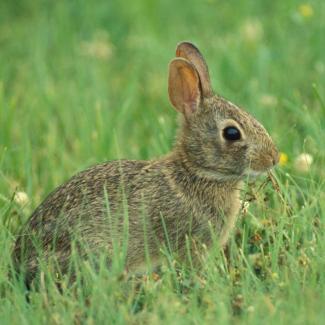Improve Your Habitat
Provide high plant diversity and heavy cover. Your rabbit-management plan should include as many of the following habitat needs as you can provide:
- Well-distributed protective cover
- An ample year-round food supply
- A safe place for nesting and development of their young
- A source of water during hot, dry spells
Threats to Rabbit Habitat
Continuous grazing
Allowing livestock to graze the same pasture all year, year after year, will eliminate the food and cover rabbits need to survive.
Unnecessary mowing
Frequent mowing of waterways, field borders, and odd areas reduces cover, promotes undesirable species, and even kills adult and young rabbits.
Monoculture farming
Large tracts of single-species crops free of fencerows and field buffers eliminate rabbit cover.
Tall fescue
This invasive, nonnative grass crowds out more beneficial grasses, weeds and wildflowers rabbits need to survive. Read the tall fescue control page for more information.
Improve Existing Cover
Fence pastured woodlots
This increases the woodlot’s timber value and, by letting the grasses and shrubs come in naturally, provides cover and food for rabbits and other wildlife. Pile up limbs from firewood and timber harvest to provide additional escape cover.
Chop and drop
If fencerows include dense, shrubby cover (and not just tall trees that harbor predators), they can make excellent wildlife habitat. They allow rabbits to enter bordering fields and then return to safety, and they furnish winter food, permitting rabbits to feed without leaving shelter. This is especially valuable during heavy snow. To create rabbit-friendly cover, “chop and drop” fenceline trees, letting their crowns lie in place.
Fence gullies
This slows erosion and promotes brush growth, improving the gully’s value for rabbits and other wildlife.
Idle your odd areas
Most farms have odd or non-agricultural areas, which have been allowed to grow sprouts, briars and brush. These usually provide excellent nesting sites and cover for rabbits, quail and other wildlife. Top larger sprouts to create both loose and dense brush piles.
Plant food plots and strip-disk
Food plots, both grain and green browse, can be added if the area is suitable. Disk strips through sods and heavy grass cover (on the contour in hilly country) to allow annual weeds to grow. A diverse assemblage of plant species and structure benefits many wildlife species. Top rabbit foods include bluegrass, Korean lespedeza, crabgrass, clovers, wheat, corn, and milo.
Fence your ponds and dams
If fenced from livestock, pond areas can provide good rabbit cover. Travel lanes or dense fencerows, which connect the pond area to nearby cover, will increase the value to rabbits. Well-grassed pond dams and terraces make excellent nesting sites for rabbits.
Don't burn bulldozed trees and brush
If clearing is necessary, brush piles can be pushed to the edges of fields or into draws. These make instant, top-notch rabbit cover, and allow forage plants to grow beneath their protective structure. Caution: Larger, compacted bulldozer piles can also provide shelter for ground predator species (raccoons, skunks, fox, coyotes, etc.).
Provide New Cover
Build brush piles
Located in the right place, brush piles bring the quickest response of all the management tools. Rabbits will often begin using a brush pile the night after it is made.
Practically any brush growth is good material. It is best to pile the brush over large rocks, old culvert pipe or discarded farm equipment. This keeps the brush off the ground and allows rabbits more freedom of movement. The pile should be 12 to 15 feet in diameter and 4 to 5 feet high. The number of piles required will depend on existing conditions. Usually, the more brush piles there are, the better it will be for rabbits.
It is important to place the brush piles in or very close to other permanent cover, such as briars, fencerows, woods or unpastured grasslands. A lone brush pile located in a closely grazed pasture is of little value to rabbits. Here, rabbits are exposed to predators while going to and from such a pile. In most cases they will not use it in winter when they need it most.
Create artificial dens
Old culverts, plastic pipes and discarded farm equipment, placed in tall grass or weeds close to permanent cover, make attractive sites for rabbits. Brush placed over the top will improve their usefulness.
Create nesting cover
Rabbits nest in grassy locations such as pastures, ditch banks, pond dams, orchards and even lawns. The importance of well-drained sites to protect the nest lining materials from becoming dampened cannot be underestimated.
Nesting sites should be protected from overgrazing, mowing and burning during the nesting season (March-September). Nesting habitat is especially important for the first litter, which is usually produced before most vegetation starts growing in early spring.
Establish and manage native warm-season grasses and wildflowers
Big bluestem, little bluestem, Indian grass, and switchgrass have tall, stiff stems that reduce wind speed, modify humidity, and soften raindrop impact. They also grow in clumps, allowing young rabbits free movement beneath protective cover. These traits provide ground-nesting wildlife more favorable conditions for survival than do most cool-season grasses (bluegrass, fescue).
Bare ground between clumps also allows the germination of other broad-leafed native plants, such as partridge pea, native lespedezas, and ragweed, which are great food sources for rabbits and other wildlife. For details on establishing and managing native warm-season grasses, visit the native warm-season grass pastures page.
Note: Without management, native warm season grasses will become too thick and reduce the bare ground and native forage rabbits and other ground-nesting wildlife need. Periodic disturbance through disking, prescribed fire, or herbicide treatment is necessary to keep grasses open and the forage plants diverse. Apply management to approximately one third of the cover each year, rotating treatment to a new patch each year.






















